As a backpacker in the early ’70s, I wasn’t picky about the food I carried; it just had to be light. Textured vegetable protein was a staple, though it was like dog food packaged for humans, and my gourmet dinner was Knorr’s powdered leek soup thickened with Ore-Ida potato flakes and cooked on a Svea 123 stove. When I switched to camp-cruising, my boats carried the weight and I could afford to indulge in better food and cooking equipment. For the past few years I’ve been doing almost all of my cruising cooking with portable table-top butane stoves. I recently added the Gas One Mini to my galley kit. It’s a dual-fuel stove that burns propane as well as butane, and I’ve been pleased with its performance, so when I saw Gas One’s 7,200 BUT dual-fuel portable camping grill, I was eager to see how it could expand my cruising cuisine.
The 8-lb 10-oz grill measures 16-1.2″ x 11-3/8″ x 4-5/8″. That’s larger than my standard butane stoves (13″ x 12″ x 4-1/4″), so it won’t fit in the galley box I built for them. It goes aboard in its plastic case. The griddle is made of cast aluminum, has a cooking surface that measures 12-3/8″ x 9-7/8″, and has a non-stick coating. Beneath it is a fat pan (stainless steel, according to the manual, but strongly magnetic) with a spout that lets drippings flow to a tray that slides into the bottom of the stove. The fat pan rests on an enameled steel support that’s open to the burner, which produces two 7″-long rows of flame. A piezo spark ignites the flame. The grill houses an 8-oz butane canister and has a hole in the back for the passage of an adapter hose when using a 1-lb propane canister.
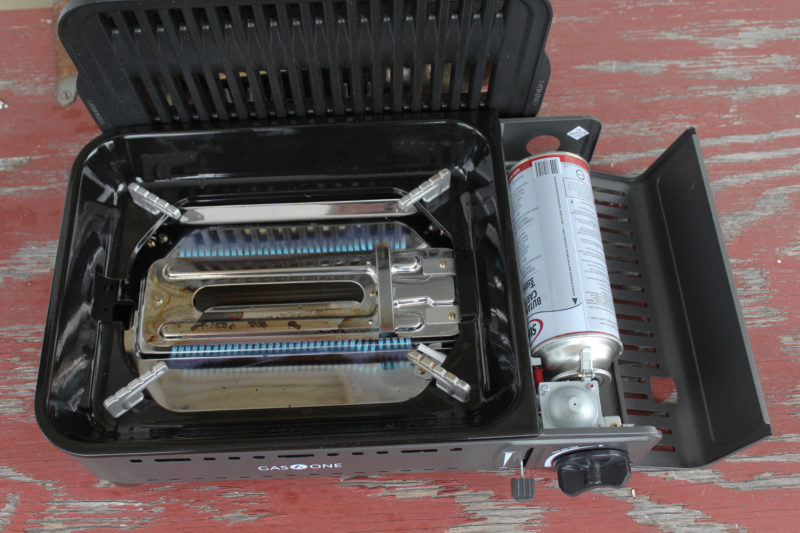 Photographs by the author
Photographs by the authorButane fuel canisters fit in the compartment to the right, here with its hinged lid open. The griddle has been removed to show the burner element and the two rows of blue flames that it produces.
The stove is easy to operate: press the lever down to engage the butane cartridge (if that’s what’s being used), turn the dial until the igniter starts the flame, then adjust the flow of gas. The fat pan can be a chore to clean, but the griddle easily sheds grease and grime. I weighed the canisters after several cooking jobs, and while how long they last depends on the setting of the dial, the calculations I made with it in the two-thirds to three-quarters range came to 1 hour 45 minutes for butane and 4 hours 20 minutes for propane. These figures may be a bit generous, as fuel delivery is better from a nearly full can than a nearly empty one. The griddle is for outdoor use; the instruction manual has a carbon monoxide warning and cautions against using the griddle indoors. Some foods—raw chicken, for example—can produce a fair bit of smoke that needs someplace to go.
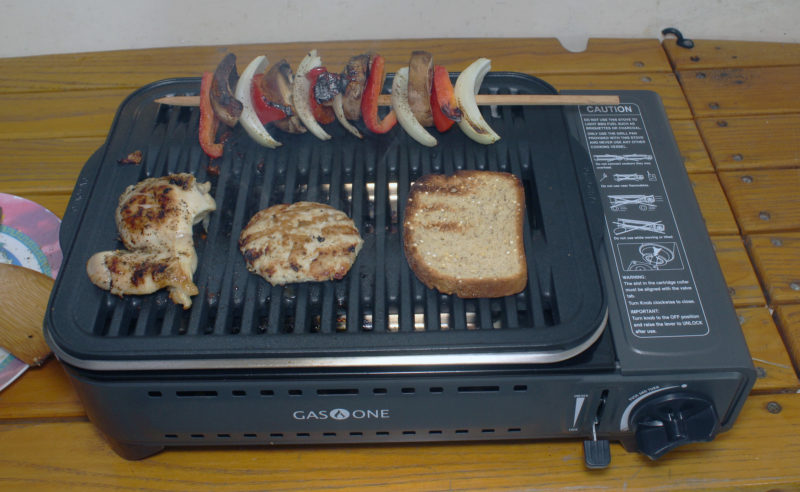
The grill has provided several welcome additions to my cruising cuisine, including kebabs, grilled chicken, turkey burgers, and toast.
The fare I had in mind for the griddle—dishes I was unable to cook with pots and pans on my stove—all worked out well on it. Turkey patties, salmon patties, veggie burgers, kebabs, mahi-mahi fillets, and chicken all got their stripes on the griddle and had a taste and texture that pan-frying can’t achieve. (Although I gave up beef and pork decades ago, I’d venture that they would cook just fine, but perhaps produce more drippings.) Skinless, boneless chicken was the slowest to cook of the foods I’ve tried, so cutting it into quick-cooking strips will save fuel and time.
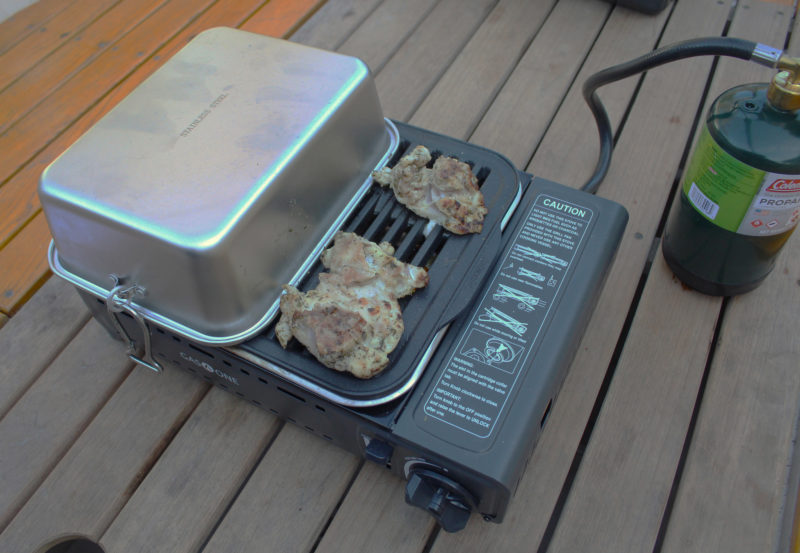
Having a cover quickens the cooking, especially in cold weather. The chicken thighs outside of the cover here took several minutes longer to cook than those under it. To burn propane, an adapter hose and fitting connects the stove to a 1-lb canister.
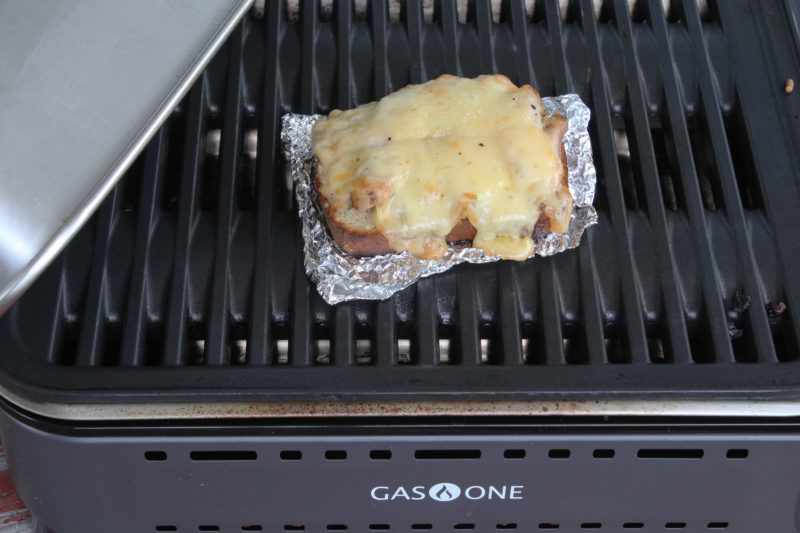
An open-face sandwich with melted cheddar on grilled chicken warmed up nicely under the cover while resting on a bit of foil. Crinkled and folded into four layers, the foil kept the bread from getting scorched.
I used the grill on a couple of cold evenings (down to 44 degrees) and that slowed cooking, so I bought an 8″ x 10″ x 3″ stainless-steel baking pan to use as a cover. There was no way to get a hold of the cover when hot, so I added a pair of stainless-steel pad-eyes, fastened with rivets made of aluminum nails. The cover speeded up cold-weather cooking significantly, and because the pan does not completely cover the griddle, it doesn’t seem to affect the function of the grill. When not in use, the pan holds two butane cartridges and serves as a wash basin.

A dream come true: pizza at anchor. A 10″ cook-pot lid turns the grill into a pizza oven. With the heat on low, the cheese melts before the crust chars.
Using a cover with the grill makes it function like a toaster oven, an unexpected bonus, and I’ve happily added pizzas, toast, and open-faced grilled-cheese sandwiches to my camp-cruising cuisine. Foil, crumpled then straightened out and folded, makes a good insulator to keep bread and crust from charring as the toppings are warming and the cheese is melting. French fries, grilled under the cover, also worked out well. I just cut 3/8″-thick strips, rotated them a time or two and in about 10 to 12 minutes, they were ready.
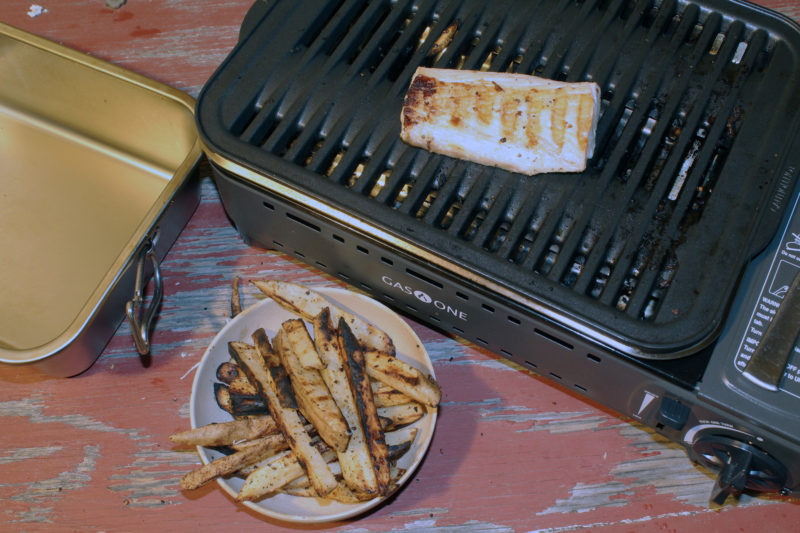
Fish ‘n’ chips. Mahi-mahi fillets cooked quickly and tasted great. A russet potato, cut into french-fry sticks and brushed with olive oil, cooked surprisingly quickly.
In my 20s and 30s I relished roughing it and was quite content to suffer through cold, wet weather and get by with meager meals. I got over that, and now I like cruising in comfort with meals that I can look forward to. The Gas One Griddle opens up a lot of possibilities.![]()
Christopher Cunningham is the editor of Small Boats Magazine.
The GS-2400P Portable Stove with Griddle is available from Gas One for $83.99. I purchased mine from Amazon for $71.99.
Is there a product that might be useful for boatbuilding, cruising, or shore-side camping that you’d like us to review? Please email your suggestions.
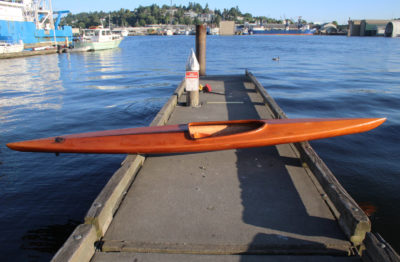
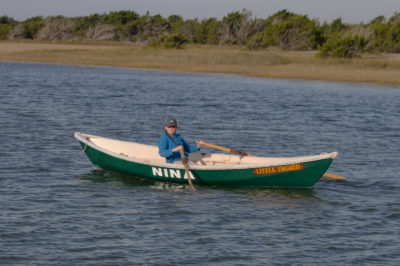
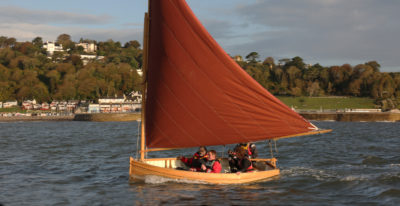
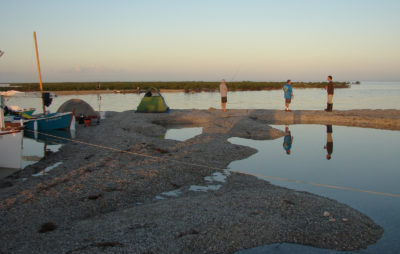
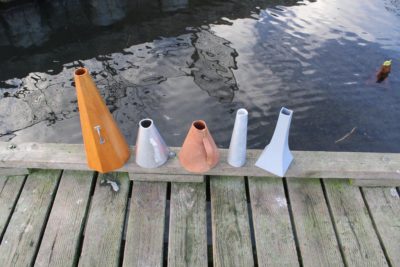
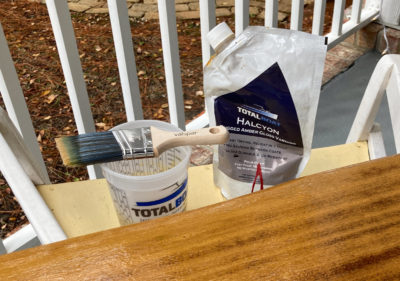

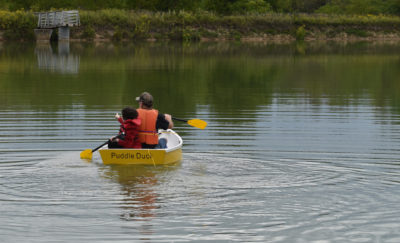

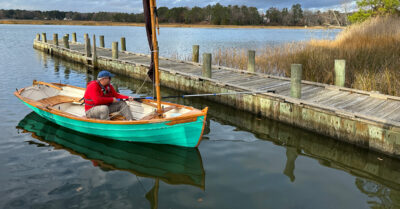
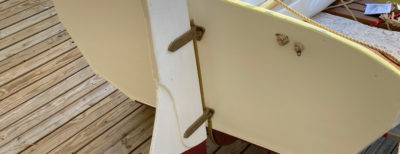
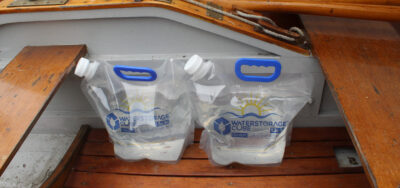
Hi Chris:
I especially liked your sense of humor in your introductory remarks. You’re good at it and should include it more in your articles.
Living in Florida most of the year, except for sailing our Hunter 40.5 in New England waters in the summer, we also have experienced “camping conditions” resulting from hurricanes that hit the Martine, St. Lucie, and Indian River counties in 2004. Frances and Jeanne hit the coast within 3 or so miles around the Stuart, Florida, area, putting our barrier island, North Hutchinson, and south of us in the hurricane’s worst sector.
After Ivan, between the two storms, dumped 5″ to 6″ inches of rain on compromised roofs, we returned after a hiatus at a friend’s in Georgia.
Obviously the island was devastated. Upon entering, we both cried at the destruction our community suffered. As boaters, we were prepared to “rough it out.” We purchased a Coleman one-burner stove and provisions to tough it out.
One of the provisions was Vienna Sausage. As you aptly describe it as dog food packaged for humans, we would recommend that Vienna Sausage roams in this same humane dog food realm for humans.
Although we would recommend being prepared, we do not recommend that diet for a short time disaster food supply. Spam might be better next time but we may try it in advance just in case another hurricane hits us.
I can’t help but see a real mess to clean up after using this grill. But then cleaning up on a small boat has always appeared problematic to me so I tend to stick with boiling water for coffee while relying on peanut butter, fruit, cheese and charcuterie to keep body and soul together. It’s a system I developed over years of motorcycle and VW van camping where much like on a boat waste water disposal can be an issue.
Clean up after cooking never seems to get addressed, maybe it is a little too “real” (like talking about using the head on a Sail & Oar boat)? I would like to see an article covering small boat sanitation solutions. The romance of any off-the-grid adventure can fade pretty fast without a good way to deal with the basic needs of your average human.
As I mentioned in the review, a non-stick surface makes the griddle easy to clean. The fat pan can take a bit of scrubbing to get cooked-on drippings clean, when there are drippings. Fatty foods will create more drippings to clean up. I don’t eat beef, so I didn’t cook hamburger patties; they would likely be harder to clean up after than skinless chicken thighs, the messiest of the foods I cooked. Veggie burgers, vegetable kebabs, pizza, toast, grilled cheese sandwiches, and potatoes required little to no cleaning, at most a wipe with a paper towel.
That said, cleaning up and carrying out waste—of all kinds—are concerns for camp cruising. Disposal of trash, toilet waste, and gray water from bathing and dishwashing all deserve attention. We’ll make sure the topic gets covered in these pages.
Christopher Cunningham
Editor, Small Boats Magazine
The book, How to Shit in the Woods, by Kathleen Meyer, deals with many of these issues.